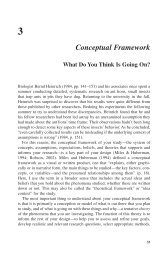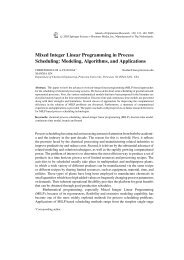The design and imaging characteristics of dynamic, solid-state, flat ...
The design and imaging characteristics of dynamic, solid-state, flat ...
The design and imaging characteristics of dynamic, solid-state, flat ...
Create successful ePaper yourself
Turn your PDF publications into a flip-book with our unique Google optimized e-Paper software.
1074 A.R. Cowen et al.<br />
channel combined with a suitable electronic display.<br />
2 <strong>The</strong> TV image is either recorded by an electronic<br />
camera tube (e.g., a Plumbicon, Saticon,<br />
Chalnicon, etc) or a semiconductor charge-coupled<br />
device (CCD) sensor. 3 Modern IITV fluoroscopy<br />
systems are capable <strong>of</strong> producing good-quality,<br />
<strong>dynamic</strong> x-ray images with economical use <strong>of</strong> radiation<br />
dose.<br />
<strong>The</strong> emergence <strong>of</strong> digital subtraction angiography<br />
(DSA) <strong>imaging</strong> equipment circa 1980 pioneered<br />
the integration <strong>of</strong> computerized video processors<br />
<strong>and</strong> magnetic storage discs with x-ray IITV systems.<br />
4 <strong>The</strong> success <strong>of</strong> DSA fuelled a seminal era in<br />
the development <strong>of</strong> digital fluoroscopy/fluorography<br />
equipment, which continued through the<br />
1990s. <strong>The</strong> availability <strong>of</strong> user-friendly, highperformance,<br />
digital x-ray IITV systems led to a<br />
radical shift in clinical <strong>imaging</strong> practice. This included<br />
the replacement <strong>of</strong> spot-film-based recording<br />
<strong>of</strong> clinical results by digital (computerized)<br />
fluorography in the screening room. This made it<br />
possible to access <strong>and</strong> replay sequences <strong>of</strong> fluorographic<br />
images on-line, <strong>and</strong> to view them in a digitally<br />
enhanced form. At the same time there was an<br />
enthusiastic adoption <strong>of</strong> radiation dose-saving measures,<br />
such as digital recursive filtering (to ameliorate<br />
noise), last image hold <strong>and</strong> two-dimensional<br />
(2D) road-mapping, further increasing the clinical<br />
usefulness <strong>of</strong> digital fluoroscopy. 5 Digital x-ray<br />
IITV systems proved flexible <strong>and</strong> effective platforms<br />
for exp<strong>and</strong>ing the range <strong>of</strong> <strong>dynamic</strong> image<br />
acquisition protocols. Digital x-ray IITV systems<br />
have been a crucial (albeit largely unsung)<br />
enabling technology in modern radiology. Notably<br />
they have underpinned the growth in x-ray imageguided<br />
interventional radiology. At the turn <strong>of</strong> the<br />
new millennium, the digital x-ray IITV system was<br />
the dominant image receptor not only for routine<br />
fluoroscopy, but also <strong>dynamic</strong> x-ray image acquisition<br />
in general. Around this time, however, a new<br />
generation <strong>of</strong> <strong>dynamic</strong> image detectors first appeared,<br />
which has subsequently gone on to<br />
threaten the established role <strong>of</strong> digital x-ray IITV<br />
systems.<br />
Solid-<strong>state</strong>, <strong>flat</strong>-panel detectors were originally<br />
<strong>design</strong>ed for use in st<strong>and</strong>ard projection radiography;<br />
the basic physical <strong>and</strong> technical <strong>characteristics</strong><br />
<strong>of</strong> these devices were described in the<br />
preceding review. 6 Solid-<strong>state</strong> digital radiography<br />
(DR) detectors provide on-line access to the electronic<br />
signal data, so the radiographic images are<br />
available to view in a matter <strong>of</strong> seconds after the<br />
exposure, (rather than after delays <strong>of</strong> several minutes<br />
more typical <strong>of</strong> conventional <strong>and</strong> computed<br />
radiography). Significantly, researchers found<br />
that with suitable technical optimization these<br />
<strong>solid</strong>-<strong>state</strong> detectors can be used equally well to<br />
record <strong>and</strong> read-out images at rates high enough<br />
to support fluoroscopy. 7,8 Prototype clinical <strong>dynamic</strong><br />
<strong>solid</strong>-<strong>state</strong> detector systems started to appear<br />
toward the end <strong>of</strong> the 1990s. 9e15 <strong>The</strong> first<br />
commercial <strong>solid</strong>-<strong>state</strong> detector-based digital fluoroscopy<br />
products became available in 2001; these<br />
detectors were <strong>design</strong>ed specifically for cardiac<br />
<strong>imaging</strong>. 16e18 In recent years most new cardiac<br />
catheterization laboratories have utilized <strong>solid</strong><strong>state</strong><br />
detectors, ousting digital x-ray IITV from<br />
one <strong>of</strong> its most celebrated clinical roles. With the<br />
recent introduction <strong>of</strong> <strong>dynamic</strong>, <strong>solid</strong>-<strong>state</strong> detectors<br />
<strong>of</strong> larger area, a similar shift away from digital<br />
x-ray IITV systems is now occurring in radiography<br />
<strong>and</strong> fluoroscopy <strong>and</strong> vascular <strong>imaging</strong>. 19e25 <strong>The</strong><br />
aim <strong>of</strong> this review is to describe the physical <strong>design</strong><br />
<strong>and</strong> <strong>imaging</strong> <strong>characteristics</strong> <strong>of</strong> the <strong>dynamic</strong>, <strong>solid</strong><strong>state</strong>,<br />
<strong>flat</strong>-panel x-ray image detectors that are<br />
driving this trend.<br />
Dynamic x-ray detector <strong>design</strong><br />
Currently, the majority <strong>of</strong> <strong>dynamic</strong> <strong>solid</strong>-<strong>state</strong><br />
detectors in clinical use are based upon the socalled<br />
‘‘indirect conversion principle’’. 6 <strong>The</strong>se detectors<br />
exploit the conversion <strong>of</strong> x-ray energy to<br />
light photons in a layer <strong>of</strong> thallium-activated<br />
caesium iodide (CsI:Tl). <strong>The</strong> emitted light is then<br />
converted to an electronic signal in a 2D array <strong>of</strong><br />
light-sensitive elements (i.e., photodiodes), fabricated<br />
in a thin layer <strong>of</strong> hydrogenated amorphous<br />
silicon (a-Si:H). CsI:Tl is a very similar scintillator<br />
to the CsI:Na used in x-ray image intensifier tubes.<br />
Caesium <strong>and</strong> iodine have comparatively high<br />
atomic numbers [Z ¼ 55 <strong>and</strong> 53, respectively],<br />
<strong>and</strong> as such have good x-ray absorption properties.<br />
Additionally they exhibit a boost in x-ray absorption<br />
at photon energies exceeding their k-edges,<br />
at 36 <strong>and</strong> 33 keV for caesium <strong>and</strong> iodine, respectively.<br />
This ensures efficient absorption <strong>of</strong> x-ray<br />
photons over the energy range that is most relevant<br />
to fluoroscopy <strong>and</strong> fluorography. <strong>The</strong> CsI:Tl<br />
layer has a columnar (pillar-like) crystal microstructure.<br />
Consequently, this phosphor has a high<br />
packing density (w90%), again helping to maximize<br />
x-ray absorption. <strong>The</strong> channelled (fibre-optic like)<br />
micro-structure <strong>of</strong> CsI:Tl helps minimize scatter <strong>of</strong><br />
the fluorescent light emission. As a result, comparatively<br />
thick layers <strong>of</strong> scintillator can be employed<br />
before spatial resolution is degraded significantly.<br />
For <strong>dynamic</strong> x-ray <strong>imaging</strong> applications a relatively<br />
thick CsI:Tl layer (typically 550e650 mm) is used to<br />
maximize detector sensitivity (<strong>and</strong>, therefore,<br />
minimize patient dose). <strong>The</strong> CsI:Tl layer absorbs
















